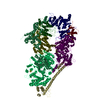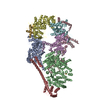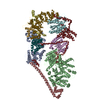+ データを開く
データを開く
- 基本情報
基本情報
| 登録情報 | データベース: PDB / ID: 6o9m | ||||||
|---|---|---|---|---|---|---|---|
| タイトル | Structure of the human apo TFIIH | ||||||
 要素 要素 |
| ||||||
 キーワード キーワード | TRANSCRIPTION / Transcription initiation / Molecular dynamics / Gene regulation / Community network analysis / Global protein dynamics / RNA polymerase | ||||||
| 機能・相同性 |  機能・相同性情報 機能・相同性情報MMXD complex / core TFIIH complex portion of holo TFIIH complex / Cytosolic iron-sulfur cluster assembly / central nervous system myelin formation / positive regulation of mitotic recombination / hair cell differentiation / hair follicle maturation / nucleotide-excision repair factor 3 complex / nucleotide-excision repair, preincision complex assembly / ventricular system development ...MMXD complex / core TFIIH complex portion of holo TFIIH complex / Cytosolic iron-sulfur cluster assembly / central nervous system myelin formation / positive regulation of mitotic recombination / hair cell differentiation / hair follicle maturation / nucleotide-excision repair factor 3 complex / nucleotide-excision repair, preincision complex assembly / ventricular system development / CAK-ERCC2 complex / transcription factor TFIIK complex / embryonic cleavage / DNA 5'-3' helicase / UV protection / adult heart development / regulation of cyclin-dependent protein serine/threonine kinase activity / G protein-coupled receptor internalization / transcription factor TFIIH core complex / transcription factor TFIIH holo complex / cyclin-dependent protein serine/threonine kinase activator activity / nuclear thyroid hormone receptor binding / transcription preinitiation complex / RNA Polymerase I Transcription Termination / DNA 3'-5' helicase / regulation of mitotic cell cycle phase transition / RNA polymerase II general transcription initiation factor activity / transcription factor TFIID complex / erythrocyte maturation / 3'-5' DNA helicase activity / hematopoietic stem cell proliferation / spinal cord development / RNA Pol II CTD phosphorylation and interaction with CE during HIV infection / RNA Pol II CTD phosphorylation and interaction with CE / HIV Transcription Initiation / RNA Polymerase II HIV Promoter Escape / Transcription of the HIV genome / RNA Polymerase II Promoter Escape / RNA Polymerase II Transcription Pre-Initiation And Promoter Opening / RNA Polymerase II Transcription Initiation / RNA Polymerase II Transcription Initiation And Promoter Clearance / Formation of the Early Elongation Complex / Formation of the HIV-1 Early Elongation Complex / bone mineralization / mRNA Capping / intrinsic apoptotic signaling pathway by p53 class mediator / ATPase activator activity / DNA topological change / RNA Polymerase I Transcription Initiation / regulation of G1/S transition of mitotic cell cycle / hematopoietic stem cell differentiation / embryonic organ development / Tat-mediated elongation of the HIV-1 transcript / Formation of HIV-1 elongation complex containing HIV-1 Tat / transcription elongation by RNA polymerase I / Cyclin E associated events during G1/S transition / response to UV / Formation of HIV elongation complex in the absence of HIV Tat / Cyclin A/B1/B2 associated events during G2/M transition / Cyclin A:Cdk2-associated events at S phase entry / cyclin-dependent protein kinase holoenzyme complex / transcription by RNA polymerase I / RNA Polymerase II Transcription Elongation / Formation of RNA Pol II elongation complex / hormone-mediated signaling pathway / transcription-coupled nucleotide-excision repair / extracellular matrix organization / RNA Polymerase II Pre-transcription Events / positive regulation of smooth muscle cell proliferation / DNA helicase activity / insulin-like growth factor receptor signaling pathway / maturation of SSU-rRNA from tricistronic rRNA transcript (SSU-rRNA, 5.8S rRNA, LSU-rRNA) / determination of adult lifespan / post-embryonic development / nucleotide-excision repair / chromosome segregation / TP53 Regulates Transcription of DNA Repair Genes / transcription initiation at RNA polymerase II promoter / transcription elongation by RNA polymerase II / promoter-specific chromatin binding / RNA Polymerase I Promoter Escape / cellular response to gamma radiation / G1/S transition of mitotic cell cycle / response to calcium ion / NoRC negatively regulates rRNA expression / Dual Incision in GG-NER / Transcription-Coupled Nucleotide Excision Repair (TC-NER) / Formation of TC-NER Pre-Incision Complex / multicellular organism growth / spindle / Formation of Incision Complex in GG-NER / Dual incision in TC-NER / Gap-filling DNA repair synthesis and ligation in TC-NER / Cyclin D associated events in G1 / intracellular protein localization / RUNX1 regulates transcription of genes involved in differentiation of HSCs / 4 iron, 4 sulfur cluster binding / response to oxidative stress / double-stranded DNA binding / 5'-3' DNA helicase activity 類似検索 - 分子機能 | ||||||
| 生物種 |  Homo sapiens (ヒト) Homo sapiens (ヒト) | ||||||
| 手法 | 電子顕微鏡法 / 単粒子再構成法 / クライオ電子顕微鏡法 / 解像度: 4.4 Å | ||||||
 データ登録者 データ登録者 | Yan, C.L. / Dodd, T. / He, Y. / Tainer, J.A. / Tsutakawa, S.E. / Ivanov, I. | ||||||
| 資金援助 |  米国, 1件 米国, 1件
| ||||||
 引用 引用 |  ジャーナル: Nature / 年: 2017 ジャーナル: Nature / 年: 2017タイトル: The cryo-electron microscopy structure of human transcription factor IIH. 著者: Basil J Greber / Thi Hoang Duong Nguyen / Jie Fang / Pavel V Afonine / Paul D Adams / Eva Nogales /  要旨: Human transcription factor IIH (TFIIH) is part of the general transcriptional machinery required by RNA polymerase II for the initiation of eukaryotic gene transcription. Composed of ten subunits ...Human transcription factor IIH (TFIIH) is part of the general transcriptional machinery required by RNA polymerase II for the initiation of eukaryotic gene transcription. Composed of ten subunits that add up to a molecular mass of about 500 kDa, TFIIH is also essential for nucleotide excision repair. The seven-subunit TFIIH core complex formed by XPB, XPD, p62, p52, p44, p34, and p8 is competent for DNA repair, while the CDK-activating kinase subcomplex, which includes the kinase activity of CDK7 as well as the cyclin H and MAT1 subunits, is additionally required for transcription initiation. Mutations in the TFIIH subunits XPB, XPD, and p8 lead to severe premature ageing and cancer propensity in the genetic diseases xeroderma pigmentosum, Cockayne syndrome, and trichothiodystrophy, highlighting the importance of TFIIH for cellular physiology. Here we present the cryo-electron microscopy structure of human TFIIH at 4.4 Å resolution. The structure reveals the molecular architecture of the TFIIH core complex, the detailed structures of its constituent XPB and XPD ATPases, and how the core and kinase subcomplexes of TFIIH are connected. Additionally, our structure provides insight into the conformational dynamics of TFIIH and the regulation of its activity. | ||||||
| 履歴 |
|
- 構造の表示
構造の表示
| ムービー |
 ムービービューア ムービービューア |
|---|---|
| 構造ビューア | 分子:  Molmil Molmil Jmol/JSmol Jmol/JSmol |
- ダウンロードとリンク
ダウンロードとリンク
- ダウンロード
ダウンロード
| PDBx/mmCIF形式 |  6o9m.cif.gz 6o9m.cif.gz | 574.3 KB | 表示 |  PDBx/mmCIF形式 PDBx/mmCIF形式 |
|---|---|---|---|---|
| PDB形式 |  pdb6o9m.ent.gz pdb6o9m.ent.gz | 442.2 KB | 表示 |  PDB形式 PDB形式 |
| PDBx/mmJSON形式 |  6o9m.json.gz 6o9m.json.gz | ツリー表示 |  PDBx/mmJSON形式 PDBx/mmJSON形式 | |
| その他 |  その他のダウンロード その他のダウンロード |
-検証レポート
| 文書・要旨 |  6o9m_validation.pdf.gz 6o9m_validation.pdf.gz | 1.1 MB | 表示 |  wwPDB検証レポート wwPDB検証レポート |
|---|---|---|---|---|
| 文書・詳細版 |  6o9m_full_validation.pdf.gz 6o9m_full_validation.pdf.gz | 1.2 MB | 表示 | |
| XML形式データ |  6o9m_validation.xml.gz 6o9m_validation.xml.gz | 103.9 KB | 表示 | |
| CIF形式データ |  6o9m_validation.cif.gz 6o9m_validation.cif.gz | 153.3 KB | 表示 | |
| アーカイブディレクトリ |  https://data.pdbj.org/pub/pdb/validation_reports/o9/6o9m https://data.pdbj.org/pub/pdb/validation_reports/o9/6o9m ftp://data.pdbj.org/pub/pdb/validation_reports/o9/6o9m ftp://data.pdbj.org/pub/pdb/validation_reports/o9/6o9m | HTTPS FTP |
-関連構造データ
- リンク
リンク
- 集合体
集合体
| 登録構造単位 | 
|
|---|---|
| 1 |
|
- 要素
要素
-TFIIH basal transcription factor complex helicase ... , 2種, 2分子 07
| #1: タンパク質 | 分子量: 87021.078 Da / 分子数: 1 / 由来タイプ: 天然 / 由来: (天然)  Homo sapiens (ヒト) / 参照: UniProt: P18074, DNA helicase Homo sapiens (ヒト) / 参照: UniProt: P18074, DNA helicase |
|---|---|
| #8: タンパク質 | 分子量: 89404.734 Da / 分子数: 1 / 由来タイプ: 天然 / 由来: (天然)  Homo sapiens (ヒト) / 参照: UniProt: P19447, DNA helicase Homo sapiens (ヒト) / 参照: UniProt: P19447, DNA helicase |
-General transcription factor IIH subunit ... , 5種, 5分子 12456
| #2: タンパク質 | 分子量: 62116.492 Da / 分子数: 1 / 由来タイプ: 天然 / 由来: (天然)  Homo sapiens (ヒト) / 参照: UniProt: P32780 Homo sapiens (ヒト) / 参照: UniProt: P32780 |
|---|---|
| #3: タンパク質 | 分子量: 52245.156 Da / 分子数: 1 / 由来タイプ: 天然 / 由来: (天然)  Homo sapiens (ヒト) / 参照: UniProt: Q92759 Homo sapiens (ヒト) / 参照: UniProt: Q92759 |
| #5: タンパク質 | 分子量: 34416.008 Da / 分子数: 1 / 由来タイプ: 天然 / 由来: (天然)  Homo sapiens (ヒト) / 参照: UniProt: Q13889 Homo sapiens (ヒト) / 参照: UniProt: Q13889 |
| #6: タンパク質 | 分子量: 8060.362 Da / 分子数: 1 / 由来タイプ: 天然 / 由来: (天然)  Homo sapiens (ヒト) / 参照: UniProt: Q6ZYL4 Homo sapiens (ヒト) / 参照: UniProt: Q6ZYL4 |
| #7: タンパク質 | 分子量: 44481.996 Da / 分子数: 1 / 由来タイプ: 天然 / 由来: (天然)  Homo sapiens (ヒト) / 参照: UniProt: Q13888 Homo sapiens (ヒト) / 参照: UniProt: Q13888 |
-タンパク質 , 1種, 1分子 3
| #4: タンパク質 | 分子量: 35873.965 Da / 分子数: 1 / 由来タイプ: 天然 / 由来: (天然)  Homo sapiens (ヒト) / 参照: UniProt: P51948 Homo sapiens (ヒト) / 参照: UniProt: P51948 |
|---|
-非ポリマー , 2種, 7分子 


| #9: 化合物 | ChemComp-SF4 / |
|---|---|
| #10: 化合物 | ChemComp-ZN / |
-実験情報
-実験
| 実験 | 手法: 電子顕微鏡法 |
|---|---|
| EM実験 | 試料の集合状態: PARTICLE / 3次元再構成法: 単粒子再構成法 |
- 試料調製
試料調製
| 構成要素 | 名称: apo TFIIH / タイプ: COMPLEX / Entity ID: #1-#8 / 由来: NATURAL |
|---|---|
| 由来(天然) | 生物種:  Homo sapiens (ヒト) Homo sapiens (ヒト) |
| 試料 | 包埋: NO / シャドウイング: NO / 染色: NO / 凍結: YES |
| 試料支持 | グリッドの材料: COPPER / グリッドのタイプ: C-flat |
| 急速凍結 | 装置: FEI VITROBOT MARK IV / 凍結剤: ETHANE |
- 電子顕微鏡撮影
電子顕微鏡撮影
| 顕微鏡 | モデル: FEI TITAN |
|---|---|
| 電子銃 | 電子線源:  FIELD EMISSION GUN / 加速電圧: 300 kV / 照射モード: FLOOD BEAM FIELD EMISSION GUN / 加速電圧: 300 kV / 照射モード: FLOOD BEAM |
| 電子レンズ | モード: BRIGHT FIELD |
| 撮影 | 電子線照射量: 40 e/Å2 フィルム・検出器のモデル: GATAN K2 SUMMIT (4k x 4k) |
- 解析
解析
| EMソフトウェア |
| |||||||||||||||||||||||||
|---|---|---|---|---|---|---|---|---|---|---|---|---|---|---|---|---|---|---|---|---|---|---|---|---|---|---|
| CTF補正 | タイプ: NONE | |||||||||||||||||||||||||
| 3次元再構成 | 解像度: 4.4 Å / 粒子像の数: 122900 / 対称性のタイプ: POINT | |||||||||||||||||||||||||
| 原子モデル構築 | プロトコル: OTHER / 空間: REAL 詳細: Initial model assembled from high-resolution structures and homology models, subsequently rebuilt in COOT, refined into the Cryo-EM map using Phenix and fully validated. |
 ムービー
ムービー コントローラー
コントローラー














 PDBj
PDBj





















